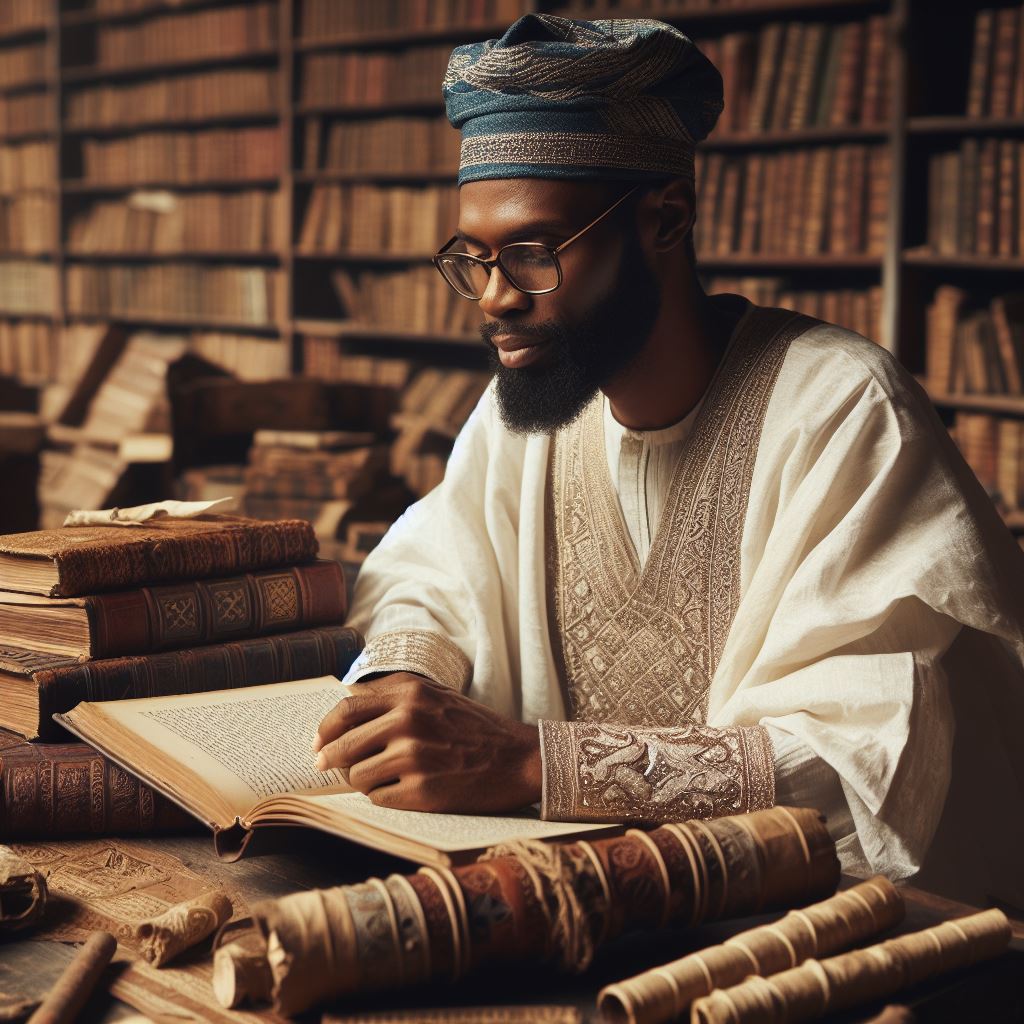Introduction
Art and literature play crucial roles in African and Asian Studies.
They offer profound insights into the regions’ cultures, histories, and identities.
Through art, we explore traditional and contemporary expressions that shape societal values.
Literature provides a narrative window into personal and collective experiences, reflecting the complexities of these regions.
These disciplines reveal how historical events and cultural exchanges influence identity formation.
Art and literature capture the essence of societal changes and cultural resilience.
By studying them, scholars gain a deeper understanding of the regions’ unique perspectives and contributions.
Art and literature also foster cross-cultural dialogues, promoting global appreciation and respect.
They challenge stereotypes and broaden our understanding of African and Asian societies.
These creative forms serve as vital tools for preserving cultural heritage and educating future generations.
In essence, art and literature in African and Asian Studies enrich our knowledge and connect us to the rich tapestry of these vibrant regions.
Historical Significance of Art and Literature
Art and literature have played a crucial role in African and Asian studies, contributing to the preservation and transmission of cultural heritage, shaping historical narratives, and fostering a deeper understanding of these regions.
Art and literature have served as valuable tools for preserving and passing down cultural heritage in both Africa and Asia.
Through various artistic forms such as painting, sculpture, music, dance, and literature, generations have been able to connect with their roots, traditions, and beliefs.
These creative expressions capture the essence of diverse cultures, allowing them to be shared with present and future generations.
Furthermore, art and literature have played a significant role in shaping historical narratives and understandings of these regions.
Artists and writers have depicted pivotal events, revolutionaries, traditions, and customs through their work, providing insights into the social, political, and economic landscapes of African and Asian societies.
Consequently, art and literature have not only served as cultural artifacts but also as primary sources for historians, anthropologists, and scholars seeking to unravel the complexities of these regions.
Role of Art and Literature in Shaping Historical Narratives
- Artists and writers have captured the struggles for independence, resilience in the face of colonization, and the triumphs of African and Asian societies.
- Through artistic representations and literary works, historical figures, events, and movements have been immortalized, allowing future generations to learn from the past.
- Art and literature have challenged dominant narratives, providing alternative perspectives on colonialism, imperialism, war, and social injustices.
- By depicting the richness and diversity of cultures in Africa and Asia, artists and writers have contributed to a more nuanced understanding of these regions.
- Artistic expressions such as paintings, sculptures, novels, poems, and plays have served as powerful vehicles for storytelling, memory, and resistance.
Understanding Cultural Heritage through Art and Literature
- Art and literature offer profound insights into the values, beliefs, customs, and traditions of diverse African and Asian communities.
- By exploring ancient myths, folk tales, epics, and oral traditions, artists and writers have shed light on the symbolic meanings embedded in cultural practices.
- Through the portrayal of everyday life, ceremonies, rituals, and celebrations, art and literature provide a window into the soul of African and Asian societies.
- Artistic expressions reflect the resilience, creativity, and ingenuity of individuals who have navigated complex historical and social landscapes.
- By delving into the visual and textual representations of cultures in Africa and Asia, scholars and enthusiasts can gain a deeper appreciation of the richness and diversity of these regions.
In essence, art and literature have been indispensable in African and Asian studies, offering profound insights into the historical, cultural, and social dimensions of these regions.
Through their creative expressions, artists and writers have contributed to the preservation of cultural heritage, the shaping of historical narratives, and a deeper understanding of the complexities of Africa and Asia.
Read: How to Apply for Communication Arts Programs
Cultural Representation in African and Asian Art and Literature
Art and literature from Africa and Asia are rich sources of cultural representation, reflecting diverse practices, beliefs, and traditions unique to each region.
- Different Art Forms: Both continents boast a variety of art forms, including painting, sculpture, textiles, and ceramics, each offering a unique insight into the culture of the region.
- Literary Works: African and Asian literature, ranging from folk tales and oral traditions to contemporary novels and poetry, provide a window into the thoughts, feelings, and experiences of their people.
- Themes of Identity: Artists and writers often explore the theme of identity in their work, delving into questions of ethnicity, nationality, and belonging.
- Migration: The experience of migration is a common theme in both African and Asian art and literature, reflecting the movement of people within and across continents.
- Colonialism: The legacy of colonialism is a prevalent theme in the artistic and literary expressions of African and Asian creators, exploring its impact on society and culture.
- Social Issues: Artists and writers often address social issues such as poverty, inequality, and injustice in their work, shedding light on the challenges faced by their communities.
Artistic Expression
In African art, traditional forms such as masks, sculptures, and textiles are not just decorative items but carry deep cultural significance.
For example, the intricate beadwork of the Maasai people in East Africa is not only visually stunning but also symbolizes social status and tribal identity.
Similarly, Asian art, whether it is the delicate brushwork of Chinese paintings or the intricate patterns of Indian textiles, reflects the diverse cultures and histories of the continent.
The symbolism and motifs used in Asian art often have spiritual or religious connotations, highlighting the interconnectedness of art and belief systems.
Literary Exploration
African literature, with its rich oral traditions and storytelling heritage, gives voice to the diverse experiences of the continent.
Writers like Chimamanda Ngozi Adichie and Chinua Achebe have explored themes of post-colonial identity, social change, and the clash of traditional and modern values.
Asian literature, on the other hand, encompasses a wide range of genres and styles, from the epic poetry of ancient India to the contemporary novels of Haruki Murakami and Salman Rushdie.
These works often grapple with timeless themes of love, loss, and the search for meaning in a rapidly changing world.
Impact on Society
The cultural representations found in African and Asian art and literature play a crucial role in shaping societal norms and values.
By portraying the complexities of identity, migration, and colonialism, these works foster a greater understanding of the diverse perspectives and histories of the regions.
Furthermore, by shedding light on social issues and injustices, artists and writers from Africa and Asia contribute to conversations about equality, justice, and human rights.
Their work serves as a powerful tool for advocacy and social change, inspiring audiences to reflect on the world around them and strive for a more equitable future.
Overall, the cultural representation in African and Asian art and literature is a testament to the richness and diversity of these regions.
Through their creative expressions, artists and writers continue to challenge, inspire, and provoke thought, inviting audiences to engage with the complexities of culture, history, and society.
Read: Introduction to African and Asian Studies in Nigeria
Impact of Globalization on African and Asian Art and Literature
Globalization has significantly influenced the production, circulation, and reception of art and literature from African and Asian regions.
This phenomenon has brought both challenges and opportunities for artists and writers in these areas.
How Globalization Has Influenced Art and Literature
- Increased Exposure: Globalization has led to greater exposure of African and Asian art and literature to a worldwide audience through various mediums such as social media, international exhibitions, and literary festivals.
- Cultural Exchange: Artists and writers from Africa and Asia have been able to engage in cross-cultural exchanges with their counterparts from other parts of the world, leading to the fusion of different artistic and literary styles.
- Commercialization: The global art market has created new opportunities for artists from these regions to sell their works internationally, but it has also raised concerns about the commodification of culture.
- Technological Advancements: The digital age has revolutionized the way art and literature are created, shared, and consumed, allowing for collaborations across borders and the creation of new forms of expression.
- Language Barrier: Globalization has also highlighted the importance of English as a dominant language in the art and literary world, which can pose challenges for artists and writers from non-English speaking regions.
Challenges and Opportunities for Artists and Writers
- Accessibility: Globalized networks have made it easier for artists and writers from Africa and Asia to reach a global audience, but there are still disparities in access to resources and opportunities.
- Cultural Appropriation: The increased exposure of African and Asian art and literature has also raised concerns about cultural appropriation, as artists and writers from other regions may exploit or misrepresent these cultural traditions.
- Identity and Authenticity: Globalization can sometimes blur the lines between traditional and contemporary artistic and literary practices, raising questions about cultural identity and authenticity in the face of globalization.
- Economic Pressures: While globalization has opened up new markets for African and Asian artists and writers, it has also created economic pressures to produce works that cater to international tastes rather than staying true to their cultural roots.
- Creative Collaboration: On the other hand, globalized networks have also enabled artists and writers to collaborate with peers from different backgrounds, leading to innovative and boundary-pushing artistic and literary works.
Overall, the impact of globalization on African and Asian art and literature is complex and multifaceted.
While it has brought about new opportunities for artists and writers to reach a global audience and engage in cross-cultural exchanges, it has also presented challenges such as cultural appropriation, language barriers, and economic pressures.
It is essential for artists and writers from these regions to navigate the complexities of globalization while staying true to their cultural heritage and artistic traditions.
Read: Famous Nigerian Alumni of Communication Arts Programs

Comparative analysis of artistic and literary movements in Africa and Asia
When comparing artistic and literary movements in Africa and Asia, it is important to note the rich cultural diversity and historical contexts that have shaped these regions.
Key Artistic Movements in Africa and Asia
- Modernism: Both Africa and Asia experienced a shift towards modernism in the 20th century, with artists rejecting traditional styles in favor of experimentation.
- Negritude Movement: In Africa, the Negritude movement emerged as a celebration of black identity and culture, influencing artists like Leopold Sedar Senghor.
- Bengal School of Art: In Asia, the Bengal School of Art in India promoted a revival of traditional Indian techniques and themes, led by artists like Abanindranath Tagore.
Key Literary Movements in Africa and Asia
- Negritude Movement: The Negritude movement also influenced literary figures in Africa, such as Aimé Césaire and Léopold Sédar Senghor.
- Maharashtrian Literature: In Asia, the Maharashtrian literature movement in India saw writers like Vishnu Sakharam Khandekar explore social issues and cultural identity.
- Moral Realism: Both regions have seen a rise in moral realism, with writers addressing political and social issues in their works, reflecting the realities of their societies.
Similarities in Themes, Styles, and Techniques
Despite their unique cultural backgrounds, artists and writers in Africa and Asia share a commonality in the themes, styles, and techniques used in their works.
- Colonialism: Both regions have grappled with the legacy of colonialism and its impact on identity, culture, and society, which is reflected in their art and literature.
- Nationalism: Artists and writers in Africa and Asia have often explored themes of nationalism, independence, and cultural heritage in response to colonial rule.
- Social Realism: There is a tendency towards social realism in art and literature, with a focus on depicting the everyday lives of ordinary people and addressing social injustices.
Differences in Themes, Styles, and Techniques
- Cultural Influences: While both regions draw on their cultural traditions, African art and literature may emphasize oral storytelling and tribal motifs, while Asian works may incorporate spiritual themes and calligraphy.
- Religious Influences: Asia’s religious diversity is reflected in its art and literature, with Hindu, Buddhist, and Islamic influences shaping artistic and literary expressions, whereas African works may draw on animist beliefs and spiritual practices.
- Language and Form: The diversity of languages and forms in Africa and Asia leads to a wide range of artistic and literary expressions, with each region showcasing unique storytelling techniques and visual styles.
All in all, the comparative analysis of artistic and literary movements in Africa and Asia reveals the interconnectedness of these regions, despite their distinct cultural heritage.
Artists and writers in both Africa and Asia continue to draw inspiration from their traditions while exploring new themes and techniques, contributing to the global dialogue on art and literature.
Read: Exploring Semiotics in Communication Arts
Representation of Social and Political Issues in African and Asian Art and Literature
- Artists and writers have used their platform to address social justice, human rights, and political struggles.
- Art serves as a powerful tool for initiating dialogue, raising awareness, and sparking change.
- In Africa and Asia, artists and writers use their work to advocate for marginalized communities and oppressed groups.
- Through literature and art, critical issues such as poverty, inequality, and discrimination are brought to light.
- Artistic expressions often challenge societal norms, question authority, and provoke thought in the audience.
How Artists and Writers Address Social Justice, Human Rights, and Political Struggles
- Many artists utilize symbolism, imagery, and metaphor to convey powerful messages about social and political issues.
- Writers craft narratives that shed light on the complexities of societal structures and power dynamics.
- Artistic expressions reflect the lived experiences of individuals who are directly impacted by social injustices.
- Through their work, artists and writers amplify the voices of marginalized communities and advocate for change.
- Art and literature serve as a platform for highlighting the resilience, struggles, and triumphs of oppressed individuals.
Role of Art and Literature in Advocating for Change
- Art and literature have the ability to provoke empathy, evoke emotions, and inspire action among audiences.
- Visual art exhibitions, poetry readings, and literary festivals provide spaces for discussions on pressing social issues.
- Artistic expressions create a sense of unity, solidarity, and collective responsibility among communities.
- Art and literature humanize the experiences of individuals affected by social and political struggles.
- Through storytelling and visual representation, artists and writers challenge the status quo and push for societal transformation.
Influence of traditional and contemporary art forms in African and Asian studies
The ways in which traditional art forms, such as music, dance, and sculpture, continue to shape contemporary artistic practices in Africa and Asia
Traditional art forms in Africa and Asia, such as music, dance, and sculpture, have played a significant role in shaping contemporary artistic practices in these regions.
These art forms are deeply rooted in the cultural, religious, and historical contexts of African and Asian societies, making them an integral part of the identity of the people.
One of the ways in which traditional art forms continue to influence contemporary art practices is through the use of motifs, symbols, and techniques that have been passed down through generations.
Artists in Africa and Asia often draw inspiration from traditional patterns and designs, incorporating them into their work to create pieces that reflect their cultural heritage.
For example, traditional dance forms such as Bharatanatyam in India or Kpanlogo in Ghana have been adapted and reinterpreted by contemporary dancers and choreographers, blending traditional movements with modern techniques to create a unique fusion of styles.
Similarly, traditional musical instruments like the kora in West Africa or the sitar in South Asia continue to be used in contemporary music compositions, adding a distinctive cultural flavor to the music.
Intersections between indigenous and modern aesthetics
There is a growing trend in African and Asian art scenes to explore the intersections between indigenous and modern aesthetics, blurring the lines between traditional and contemporary art forms.
Artists are increasingly experimenting with new mediums, materials, and technologies while still drawing on their cultural heritage to create innovative works that challenge conventional artistic boundaries.
One way in which indigenous and modern aesthetics intersect in African and Asian art is through the use of mixed media and multimedia installations.
Artists combine traditional art forms such as painting or sculpture with digital technologies, video, and interactive elements to create immersive art experiences that engage with contemporary issues and themes.
Furthermore, the concept of cultural hybridity has become a central motif in contemporary African and Asian art, reflecting the complexities of modern identity in a globalized world.
Artists explore themes of migration, diaspora, and cultural exchange through their work, examining how traditional art forms can adapt and evolve in today’s multicultural societies
- Traditional art forms like music, dance, and sculpture shape contemporary practices in Africa and Asia.
- Indigenous and modern aesthetics intersect in mixed media installations and multimedia artworks.
- Artists explore themes of migration, diaspora, and cultural exchange in their work.
Lastly, the influence of traditional art forms in African and Asian studies cannot be overstated.
These art forms not only provide a connection to the rich cultural heritage of the regions but also serve as a source of inspiration for contemporary artists looking to explore new ways of expressing their identities and engaging with the world around them.
By blending indigenous and modern aesthetics, artists in Africa and Asia are creating a vibrant and dynamic artistic landscape that reflects the complexities of their societies and the ever-changing nature of artistic expression.
Conclusion
Art and literature play a crucial role in African and Asian studies by providing insights into the cultural, social, and historical contexts of these regions.
Through artistic expressions and literary works, we are able to understand the traditions, beliefs, and experiences of diverse communities.
Additionally, art and literature serve as a powerful medium for storytelling and representation, helping to showcase the rich and complex narratives of Africa and Asia.
They contribute to the preservation of cultural heritage and promote cross-cultural understanding and appreciation.
Furthermore, by studying art and literature from African and Asian perspectives, we are able to challenge dominant narratives and foster critical thinking about global issues such as colonialism, identity, and social justice.
In closing, art and literature continue to be relevant and significant in African and Asian studies as they provide valuable insights, promote cultural exchange, and contribute to a more nuanced understanding of the world we live in.




